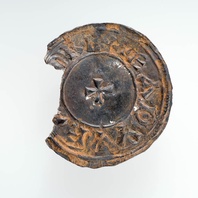
Viking Objects
Edward the Elder Penny (CM.615-1998)
A Horizontal type (HC1) silver penny of Edward the Elder (874-924), son of Alfred the Great, and minted by a moneyer called Beornwald. This coin was part of a hoard of twelve coins found at Thurcaston between 1992 and 2000. The coins are Anglo-Saxon, Arabic and Viking issues, and show the diverse and wide-ranging contacts between societies at this time. The hoard was probably deposited c.923-925, approximately five years after Leicester had been retaken by Mercia (c.918). They indicate that a bullion economy was still operating in the Danelaw as late as the 920s. This suggests that the reconquest did not immediately manage to institute Anglo-Saxon practices such as a monetary economy.
Read More
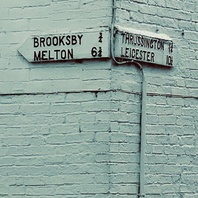
Viking Names
Brooksby
Brooksby, in the East Goscote Hundred of Leicestershire, is a difficult name. The first element is likely the Old Norse male personal name Brok which was originally a byname derived from Old Norse brók ‘breeches’. Alternatively it has been suggested that the first element is Old English broc ‘a brook, a stream (used of a stream with a muddy bed and a visible sediment load)’. This brook may refer to the River Wreake or more likely a small stream which rises near Brooksby. The first element could also be the Old Danish cognate brok ‘bog, marsh’ which is found in place-names in Denmark. However, these elements do not otherwise show a genitival structure whereas the personal name does. The second element of the name is Old Norse by ‘a farmstead, a village’.
Read More
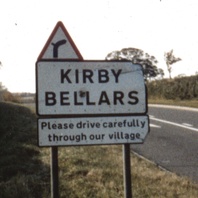
Viking Names
Kirby Bellars
Kirby Bellars, in the Framland Hundred of Leicestershire, comes from the Old Norse elements kirkja ‘church’ and by ‘farm, settlement’. The affix Bellars is derived from the personal surname Beler. Hamo Beler held the manor in 1166 and it remained in the family as late as 1361.
Read More
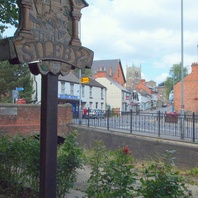
Viking Names
Sileby
Sileby, in the East Goscote Hundred of Leicestershire, comes from the Old Norse male personal name Sigulfr and the Old Norse element by ‘a farmstead, a village’.
Read More
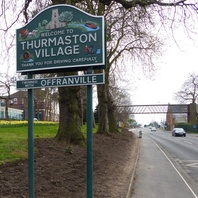
Viking Names
Thurmaston
Thurmaston, in the East Goscote Hundred of Leicestershire, is an Anglo-Scandinavian hybrid from the common Old Norse male personal name Þormóðr and Old English tun ‘an enclosure; a farmstead; a village; an estate’. A few thirteenth and fourteenth century spellings of Thurmaston seem influenced by the Old Norse male personal name Þormundr. A large pagan, Anglian cemetery has been discovered here, no doubt that of an important early settlement site preceding Scandinavian appropriation.
Read More
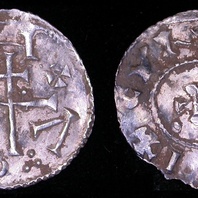
Viking Objects
Viking Silver Penny (LEIC-B230B8)
This silver ‘Cunnetti’ penny comes from the Viking kingdom of York and was minted on the authority of ‘Cnut of Northumbria’. Minting coins was a way of controlling the means of exchange within a kingdom and which created a more easily administered standardized system of trade. Moreover, the coins themselves were often used as propaganda, portraying symbols and statements that gave off a desired message. The Vikings later used the minting of coins to legitimize their own rule.
Read More
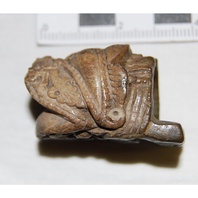
Viking Objects
Dragon’s Head Mount (L.A67.1864.1.0)
This mount from Leicester is in the form of a dragon’s head and is thought to be Scandinavian work. The base of the head is extended, slotted and necked as though for a hinge. There are green stains suggesting that it was attached to an item of copper or bronze. Mounts were generally used to decorate various items such as belts or pouches. In this case, it may have been a fitting for a knife. Mounts were usually attached to items by hammering over the metal studs on the back of the mount.
Read More
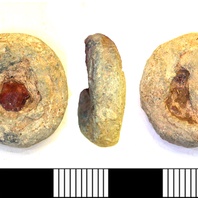
Viking Objects
Circular Weight (LEIC-5C4051)
This circular weight has a centrally placed orange stone chip inlaid into it. The distinction of weights by embedded objects or other embellishments in various media is a widely recognised feature of some early medieval weights. Weights are an important form of evidence for Viking Age commerce and the use of standards across the different economic systems within which Vikings were integrated. Many of the weights discovered, particularly ones in Ireland and those of Arabic type, suggest that a standardized system of weights existed in some areas. These standard weights, alongside standard values of silver, are what allowed the bullion economy of Viking occupied areas to function. A bullion economy was a barter economy that relied on the exchange of set amounts of precious metal in various forms, such as arm-rings or coins, for tradable goods, such as food or textiles. Each merchant would have brought their own set of weights and scales to a transaction to make sure that the trade was conducted fairly.
Read More
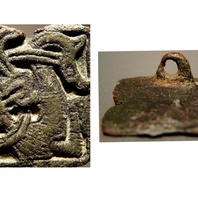
Viking Objects
Mammen-Style Square Brooch (LEIC-0BFA74)
This small brooch features a bird depicted in the Mammen style. This style of brooch appears to have been produced in the Danelaw but, generally, Mammen-style decoration is rare in Britain. This brooch from Linwood, Lincolnshire, is paralleled by examples from West Stow Heath, Suffolk, and Bergh Apton, Norfolk, but further examples from Cambridgeshire and East Anglia were found in 2015 and 2016. It is a type which has Carolingian-inspired shapes and Scandinavian decoration. Such brooches were an accessory for women who wore Scandinavian dress. For more information on Scandinavian jewellery in England check out our blog: Brooches, Pendants and Pins: Scandinavian Dress Accessories in England.
Read More
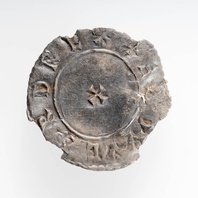
Viking Objects
Edward the Elder Penny (CM.616-1998)
A silver Horizontal type (HT1) penny of Edward the Elder (c. 874-924) minted in London by Garead. Edward was the son of Alfred the Great and succeeded him as king of Wessex. This coin was part of a hoard of twelve coins found at Thurcaston between 1992 and 2000. The coins are Anglo-Saxon, Arabic and Viking issues, and show the diverse and wide-ranging contacts between societies at this time. The hoard was probably deposited c.923-925, approximately five years after Leicester had been retaken by Mercia (c.918). They indicate that a bullion economy was still operating in the Danelaw as late as the 920s. This suggests that the reconquest did not manage to institute Anglo-Saxon practices such as a monetary economy immediately.
Read More
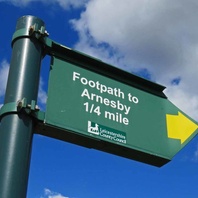
Viking Names
Arnesby
The first element of Arnesby, in the Guthlaxton Hundred of Leicestershire, is likely the Old Danish male personal name Iarund (Old Norse Iǫrundr) which might have given a Middle English form Erendes in the genitive. However, it has been argued that the specific element might be the Scandinavian appellative erendi ‘errand, message’ which may be an unrecorded byname. The second element is Old Norse by ‘a farmstead, a village’.
